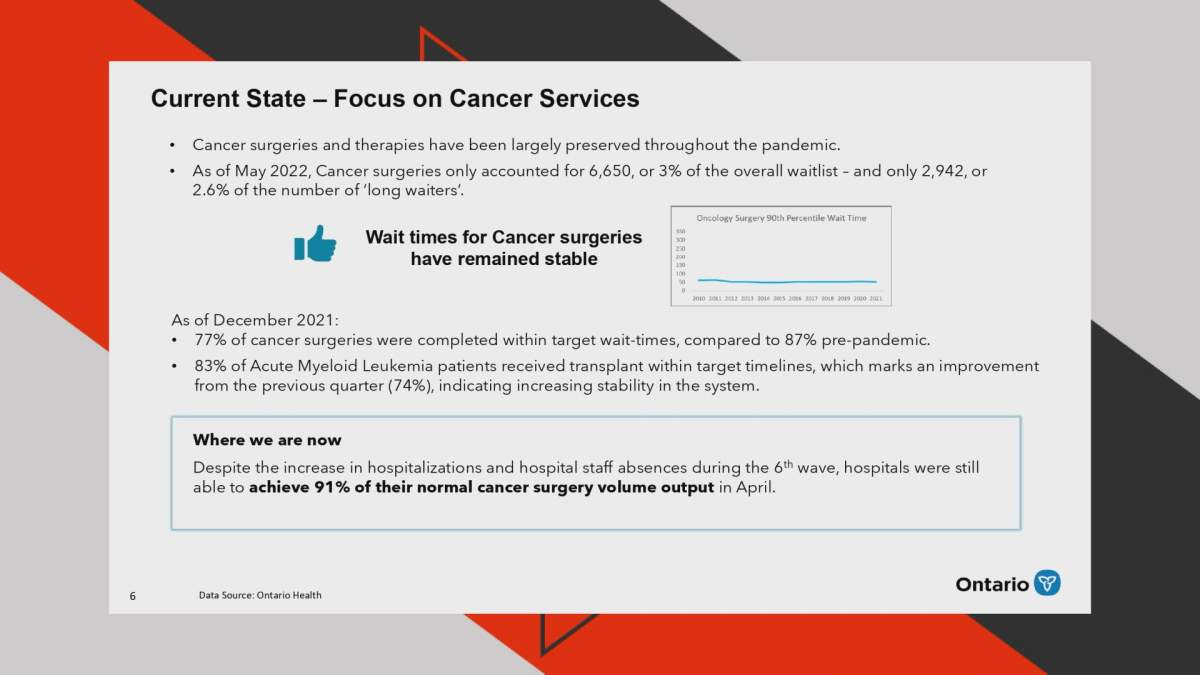Ontario doubled the number of so-called “long-waiters” during the pandemic — patients whose surgeries have been delayed longer than their maximum clinical guidelines — according to figures obtained by Global News, leading to concerns about poorer medical outcomes.

According to government documents, almost half of the patients on Ontario’s surgical wait-list were forced to delay longer than doctors would recommend — a 123 per cent increase compared with pre-pandemic levels.
In early 2022, the number of patients waiting longer than recommended sat at 105,000, according to the data compiled by the Ministry of Health, at a time when hospitals were delaying non-urgent surgeries to preserve capacity amidst the onset of the Omicron variant of COVID-19.
In 2019, an average of 47,000 people on Ontario’s surgical list were waiting longer than clinical guidelines for their procedure, representing 23 per cent of the total number on the surgical wait-list.
By 2022, the number of long-waiters grew to represent 43 per cent of the 250,000-person wait-list, according to ministry documents obtained by Global News.
Dangers of waiting
“Delayed care will inevitably lead to complications,” David Gomez, an acute care and trauma surgeon in Toronto, told Global News.
“From the most common procedures that are performed in Ontario — which are cataracts, hips and knees, inguinal hernias — the likelihood of delayed operation leading to death is very, very, very low. It is not zero, but it is very, very low.”
The chance a delay will impact quality of life, however, is high, Gomez said.
The delay could cause increased pain or discomfort or the potential for more trips and falls, for example, with decreased mobility or vision, depending on the procedure.

According to a recent report by the Fraser Institute on access to health care in Canada, long wait times are more than a “benign inconvenience,” they can leave patients with serious consequences such as increased pain and suffering, mental anguish and long-term risks.

Get weekly health news
“In certain instances, they can also result in poorer medical outcomes—transforming potentially reversible illnesses or injuries into chronic, irreversible conditions, or even permanent disabilities,” the report states.
The Fraser Institute also indicated patients, in some cases, forgo their wages while they await treatment.
“In the ideal surgical system, I believe long-waiters should not exist because we’re defining a clinical threshold where we expect that some patients — not the majority, some patients — will experience added morbidity complications from waiting,” Gomez said.
Ford government will not say if situation has improved
While the Ford government has thrown millions of dollars at the problem, including leaning on independent health facilities to reduce the backlog, the province refused to say whether it has successfully shrunk the number of long-waiters in the system.
Repeated requests for updated data and information have not been fulfilled and a spokesperson for Ontario Health said, on Dec. 4, 2022, that the wait-list for surgery sat at around 209,000 people, down from 250,000 people recorded in April.
In response to further questions on Jan. 23, an Ontario Health spokesperson said the number of long-waiters “has begun to trend downwards, as we have prioritized having patients get their surgery within recommended wait times.”
They said that between Nov. 28 and Dec. 4 2022, 77 per cent of cancer surgeries were completed within target times but did not provide any specifics for the overall number of long-waiters.
That is the same figure for cancer surgeries as 2021, according to the briefing documents obtained by Global News.
A slide titled “focus on cancer surgeries” said in December 2021, 77 per cent of surgeries were completed on time, compared with 87 per cent pre-pandemic.
Global News obtained the figures as part of a freedom of information request for portions of the transition binder presented to new Health Minister Sylvia Jones during the summer.
That document — entitled Surgical and Diagnostic Recovery: Foundation Overview — should have been presented to the minister as she was introduced to her role.
“The Ministry’s surgical recovery programs are targeted at reducing the number of long-waiter patients from current levels ~110K to pre-pandemic normal of less than 50K,” one line included in the presentation states.
The surgical recovery program includes funding for expanded health-care hours, additional MRI and CT times and “targeted funding for pediatric and private hospitals,” another slide explains.
However, as Ontario hospitals buckled under the pressure of a respiratory syncytial virus (RSV), influenza and COVID-19 triple threat during the fall, some were forced to ramp surgeries back down.
In eastern Ontario, one children’s hospital even received aid from the Red Cross.
Provincial officials have not been clear about how that latest wave of sickness has impacted long-term plans to tackle the number of long-waiters in Ontario.
“To prioritize those who have waited beyond their target time for surgery and to help Ontarians get their non-urgent surgeries and procedures faster, the Ministry of Health has invested $300 million in 2022–23,” Ontario Health told Global News.











Comments